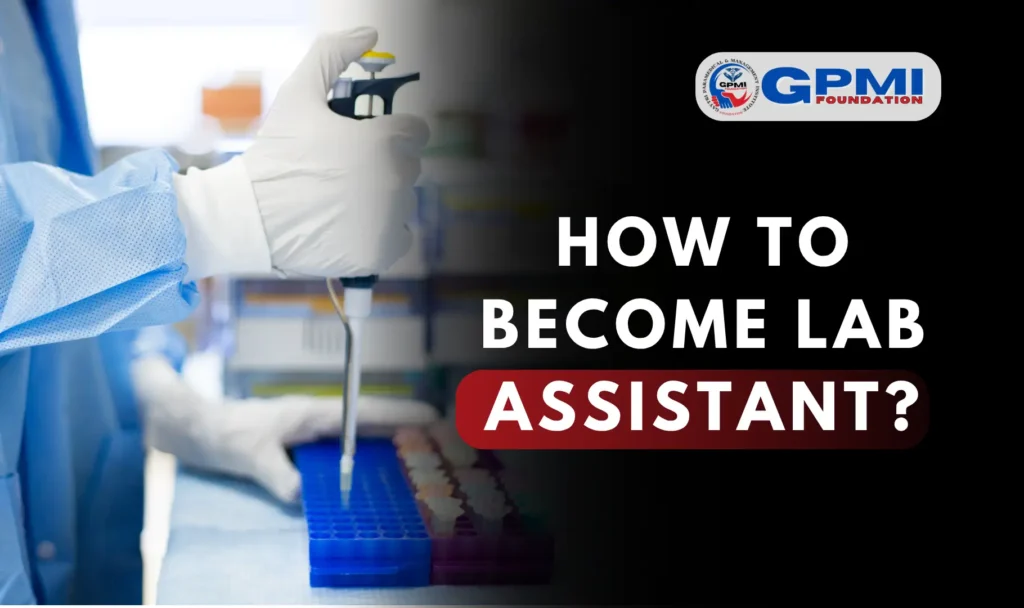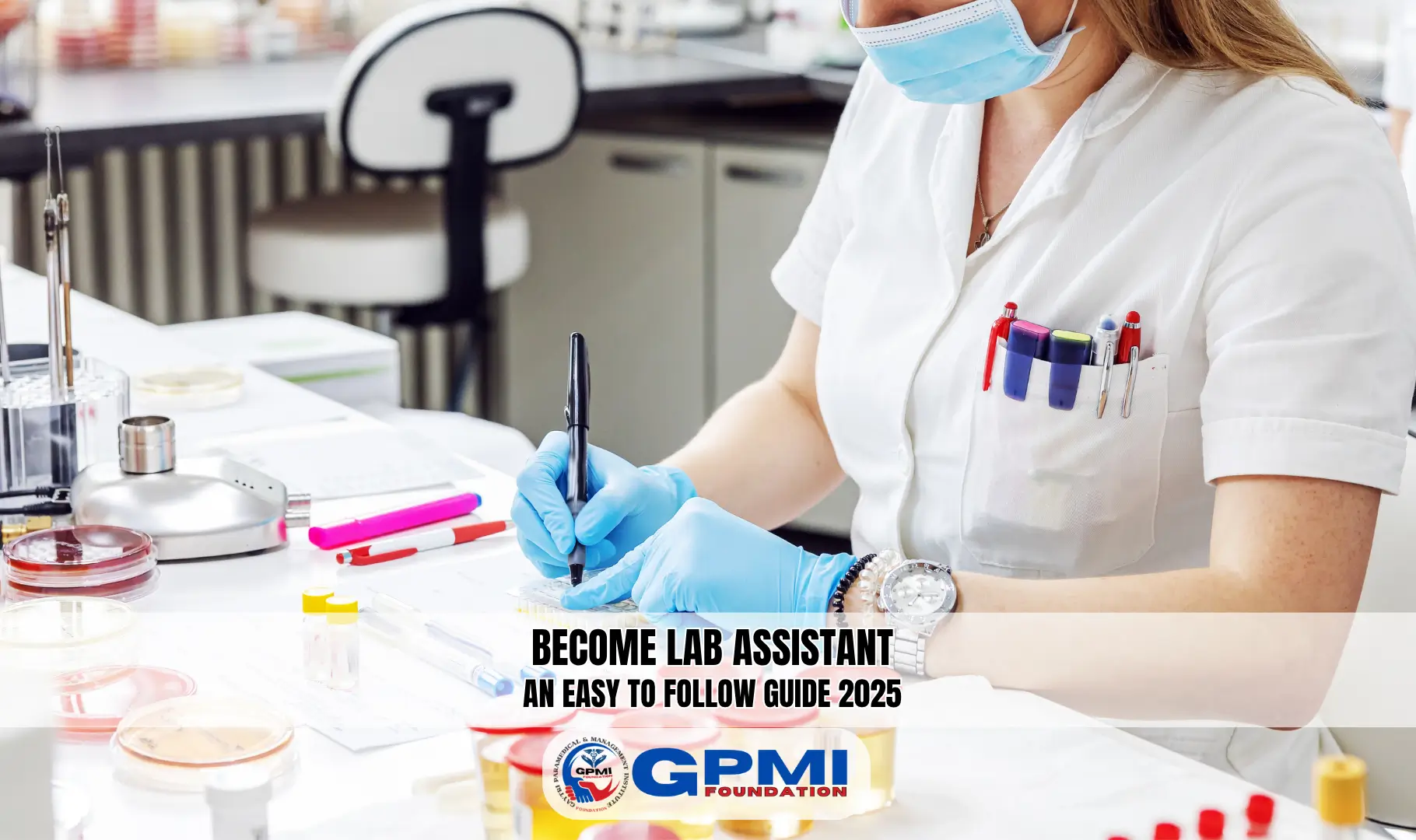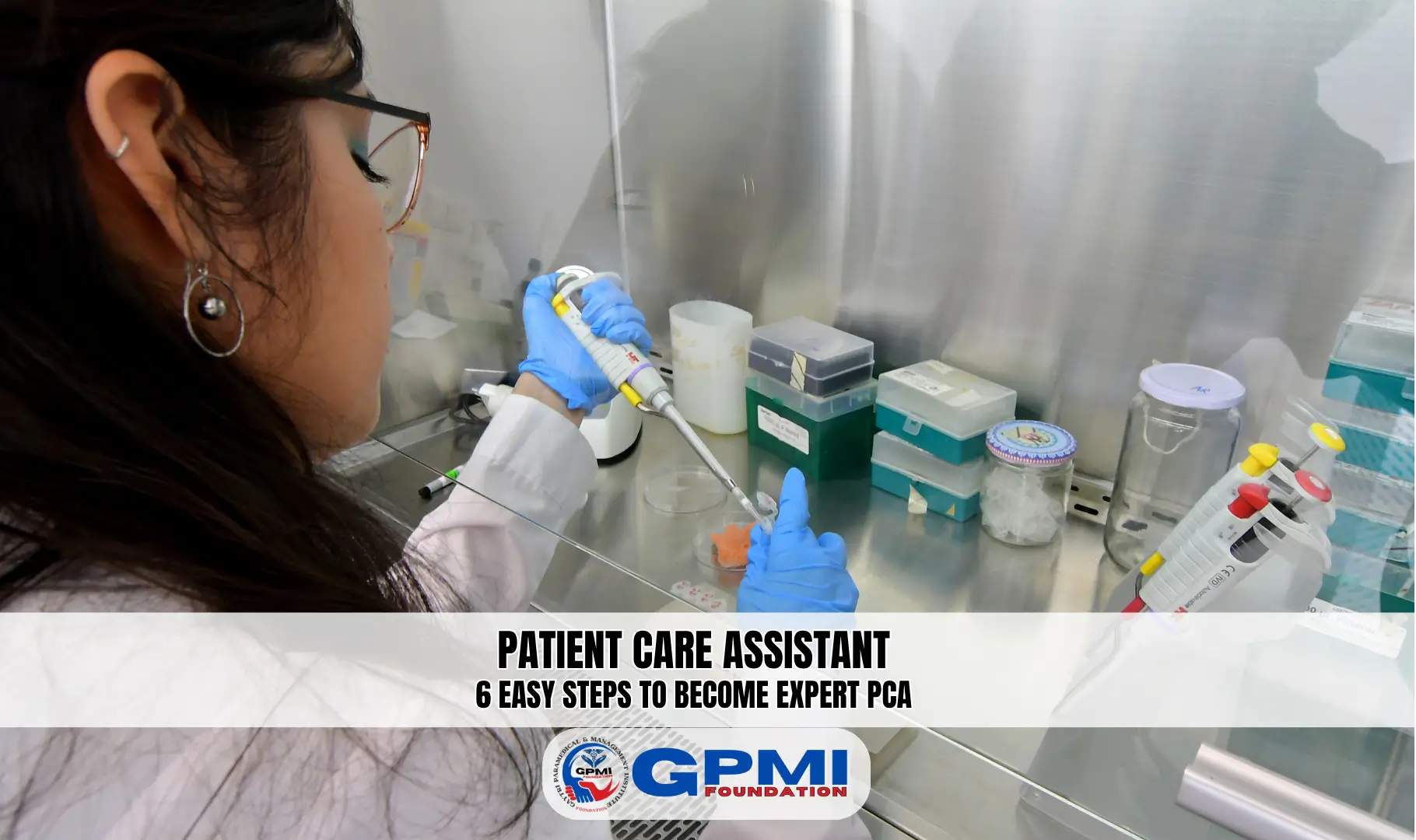Have you ever wondered who helps doctors and scientists test blood, urine, or other samples in hospitals and labs? That’s the job of a lab assistant. They may not wear a white coat like a doctor, but they play a very important role behind the scenes. In fact, without lab assistants, it would be difficult to diagnose diseases or run medical tests properly.
If you are a student who has passed class 10th or 12th and are interested in working in the healthcare field, becoming a lab assistant could be a great career choice for you. It doesn’t take many years to become one, and there are good job opportunities in hospitals, private labs, and clinics.
In this guide, we’ll explain everything you need to know – what a lab assistant does, what course you need to take, how much time it takes, and what kind of job you can get after completing the course.
Table of Contents
What is a Lab Assistant?

A Laboratory Assistant is a trained healthcare or science professional who works in a laboratory and helps with various tests, experiments, and sample collections. Their main job is to support doctors, scientists, and lab technicians by preparing samples, cleaning equipment, labeling test tubes, and sometimes even performing basic tests under supervision.
In a medical lab, a lab assistant handles blood, urine, stool, or other body fluid samples collected from patients. They make sure the samples are properly stored and sent for testing. They also maintain the cleanliness of the lab and ensure that all tools and machines are working correctly.
Lab assistants are important because they help in quick and accurate diagnosis of diseases. Without them, the lab would not function smoothly. A person with good observation skills, attention to detail, and basic science knowledge can become a successful lab assistant. It’s a job that requires responsibility, care, and a strong interest in healthcare or science.
What Are Lab Assistant Course?
Lab Assistant courses are short-term training programs designed to teach students the skills and knowledge needed to work in a laboratory. These courses are perfect for students who have completed their 10th or 12th class and are interested in science and healthcare. The main goal of these courses is to prepare students to work as assistants in medical labs, diagnostic centers, hospitals, or research labs.
During the course, students learn how to collect and handle patient samples like blood and urine, how to operate basic lab equipment, and how to maintain cleanliness and safety in the lab. They are also trained in preparing slides, labeling test tubes, and helping lab technicians with different tests.
Most lab assistant courses last from 6 months to 1 year and are offered by paramedical institutes and vocational training centers. After completing the course, students can apply for jobs as lab assistants or lab technicians in healthcare settings.
Lab Assistant Qualification
To become a Lab Assistant, students must meet basic educational qualifications and complete a certified training course. The minimum eligibility is usually a 10th or 12th pass, preferably with a science stream (Physics, Chemistry, Biology). But all streams students can apply for the course.
There are different course options available:
- Certificate in Laboratory Assistant (Duration: 6 months to 1 year) – Suitable for 10th or 12th pass students.
- Diploma in Medical Laboratory Technology (DMLT) (Duration: 1 or 2 years) – Requires 10+2 with science.
- Bachelor in Medical Laboratory Technology (BMLT) or B.Voc. in MLT (Duration: 3 years) – Ideal for students who want to study further and work as senior lab professionals.
These courses provide both theory and practical training in sample collection, lab safety, equipment handling, and test procedures. After completing the course, students become eligible to work as lab assistants in hospitals, diagnostic centers, and clinics.
Lab Assistant Syllabus
The syllabus for Lab Assistant courses is designed to provide both theoretical knowledge and practical skills needed to work in medical laboratories. Whether it is a Certificate in Laboratory Assistant course or a Diploma in Medical Laboratory Technology (DMLT), the syllabus focuses on subjects that help students understand how to assist in performing diagnostic tests safely and accurately.
Here are the main subjects and topics usually covered in the Lab Assistant syllabus:
- 1. Basics of Human Anatomy and Physiology: Introduction to body systems, Functions of organs, Blood circulation and digestion
- 2. Clinical Biochemistry: Blood sugar testing, Kidney and liver function tests, Use of chemicals and reagents
- 3. Microbiology: Study of bacteria, viruses, and fungi, Sample collection and culture methods, Microscope handling
- 4. Hematology: Blood collection techniques, Blood grouping and typing, Hemoglobin and cell count tests
- 5. Laboratory Equipment and Safety: Use of lab instruments like centrifuge, microscope, colorimeter, Sterilization and disinfection, Waste disposal and biosafety rules
- 6. Urine and Stool Examination: Physical, chemical, and microscopic examination, Sample preservation and reporting
- 7. Pathology: Study of diseases through lab tests, Slide preparation and staining techniques
The syllabus may vary slightly based on the institute and course duration. However, all programs aim to train students for real lab work with hands-on practice.
What is The Work of Lab Assistant
The work of a Lab Assistant is to support doctors, lab technicians, and scientists in conducting medical tests and experiments in laboratories.
- Their main duties include collecting samples like blood, urine, or stool from patients, labeling and storing them properly, and preparing them for testing.
- Lab assistants also help in operating basic lab equipment such as microscopes, centrifuges, and colorimeters.
- They are responsible for cleaning and sterilizing tools, maintaining proper hygiene in the lab, and ensuring that test tubes, slides, and other materials are available and ready. In some labs, they also perform simple tests under the supervision of senior staff.
- Another important part of their work is recording test results and managing patient data carefully.
- Lab assistants play a key role in helping diagnose diseases by making sure that the tests are done smoothly and accurately.
- Their job requires attention to detail, discipline, and a strong sense of responsibility.
Top Skills Every Lab Assistant Must Have
To perform these tasks efficiently, lab assistants need certain important skills, such as:
- Attention to Detail – To avoid errors while labeling or testing
- Basic Computer Skills – For data entry and report handling
- Good Communication – To interact with patients and lab staff
- Time Management – To handle multiple tasks and meet deadlines
- Knowledge of Lab Safety Rules – To prevent contamination or accidents
These skills, along with proper training, help lab assistants perform their duties professionally and responsibly.
How to Become Lab Assistant?

Becoming a Lab Assistant is a great career option for students who are interested in science and want to work in the healthcare or laboratory field. If you’re thinking about this career, here is an easy step-by-step guide to help you become a lab assistant.
Step 1: Complete Your Basic Education
To start your journey as a lab assistant, the first step is to pass 10th or 12th class. Most institutes prefer students from a science background (with Biology, Physics, or Chemistry), especially for diploma or advanced-level courses. However, some certificate-level courses may accept students with a 10th pass as well.
Step 2: Choose the Right Lab Assistant Course
Once you finish your schooling, you need to enroll in a certified lab assistant course. Here are the most common options:
- Certificate in Laboratory Assistant
Duration: 6 months to 1 year
Eligibility: 10th or 12th pass
Focus: Basic lab skills, sample handling, lab hygiene - Diploma in Medical Laboratory Technology (DMLT)
Duration: 1 to 2 years
Eligibility: 10+2 with science (Biology preferred)
Focus: Advanced skills in hematology, pathology, microbiology, and biochemistry - B.Voc. in Medical Lab Technology (MLT)
Duration: 3 years
Eligibility: 12th with science
Focus: Detailed learning with more career growth opportunities
Choose a course based on your interest, eligibility, and time you want to invest.
Step 3: Learn Practical Skills During the Course
During your course, focus on both theory and practical training. You will learn:
- How to collect and label blood, urine, and stool samples
- How to use lab equipment like microscopes, centrifuges, and colorimeters
- How to maintain safety and hygiene in the lab
- How to prepare slides, chemicals, and reagents
- How to follow standard operating procedures for different tests
These hands-on skills will help you perform better in real-life work situations.
Step 4: Complete Internship or Training (If Available)
Some courses or institutes provide a short internship or on-the-job training in hospitals or diagnostic labs. This experience is very valuable because you get to work in a real laboratory and understand the workflow, time management, patient interaction, and test accuracy.
Even if your course doesn’t include training, try to get voluntary experience in a lab nearby. It boosts your confidence and strengthens your resume.
Step 5: Apply for Jobs as a Lab Assistant
Once your course is completed, you can start applying for jobs. Common places where lab assistants work include:
- Hospitals (government and private)
- Diagnostic laboratories
- Pathology labs
- Blood banks
- Research centers
- Clinics and health camps
Create a simple resume with your qualification, training, and practical experience. Highlight your skills such as sample handling, equipment use, and knowledge of safety protocols.
Lab Assistant Salary: The salary of a Lab Assistant depends on factors like qualification, experience, and the type of workplace. On average, a fresher can earn between ₹8,000 to ₹15,000 per month in private clinics or labs. With experience, salaries can rise to ₹20,000–₹30,000 or more, especially in hospitals or government jobs.
Step 6: Keep Learning and Grow in Your Career
Lab technology is always growing with new tests and machines. To stay up-to-date and move ahead in your career, you can:
- Join advanced diploma or B.Voc. courses
- Learn new techniques like PCR, ELISA, or COVID-related testing
- Take part in workshops or online lab safety programs
- Prepare for government lab technician exams
With time and experience, you can grow from lab assistant to senior lab technician, lab manager, or even open your own diagnostic lab.
Becoming a lab assistant is not difficult if you follow the right steps. Start with your basic education, choose a suitable course, gain practical skills, and look for job opportunities. With hard work, you can build a stable and respected career in the healthcare field. It’s a job that may be behind the scenes, but it makes a big difference in people’s lives every day.
Lab Assistant Vs Medical Lab Technician

Many students get confused between a Lab Assistant and a Medical Lab Technician (MLT). Though both work in laboratories and are involved in testing and diagnosis, their roles, responsibilities, qualifications, and salaries are different. Here’s a simple comparison to help you understand the difference:
Qualification Required
- Laboratory Assistant: Usually requires a 10th or 12th pass with a short-term certificate or diploma course (6 months to 1 year).
- Medical Lab Technician (MLT): Requires 10+2 with Science and a Diploma (DMLT) or Bachelor’s Degree like B.Voc. or B.Sc. MLT (2–3 years).
Roles and Responsibilities
- Lab Assistant: Focuses on supporting tasks like collecting samples, labeling, cleaning tools, preparing equipment, and assisting technicians.
- MLT: Performs complex tests such as blood analysis, urine examination, microbiological cultures, and generates lab reports.
Level of Skill and Training
- Lab Assistant: Basic knowledge of sample handling, lab safety, and simple test support.
- MLT: Advanced knowledge of pathology, biochemistry, hematology, and using modern lab equipment.
Salary Range
- Laboratory Assistant: ₹8,000 – ₹15,000 per month (entry-level)
- MLT: ₹15,000 – ₹30,000 per month or more, depending on experience and qualifications.
Career Growth
- Lab Assistant: Limited growth unless further education is done.
- MLT: Better growth opportunities in hospitals, diagnostic centers, and research labs.
If you’re looking for a quick job in healthcare after 10th or 12th, becoming a lab assistant is a good start. But if you want a stable and long-term medical lab career with higher pay, becoming a Medical Lab Technician is the better choice.
Lab Assistant Vs Phlebotomy

Both Job roles work closely with medical samples and play important roles in diagnosis and treatment, their job responsibilities, skills, and qualifications are quite different. Understanding the difference can help you decide which path suits your interest better.
Job Role and Duties
- A lab assistant works inside a medical or diagnostic lab. Their duties include collecting and labeling samples, cleaning and sterilizing lab equipment, preparing chemical reagents, and assisting lab technicians in running simple tests. They may also manage patient records and help in maintaining the overall cleanliness and function of the lab.
- A phlebotomist is a trained professional who specializes in drawing blood from patients for tests, donations, or transfusions. They often work directly with patients in hospitals, labs, blood banks, or health camps. Their key responsibilities include finding veins, using sterilized needles, handling patient anxiety, and safely storing blood samples.
Qualification and Training
- Lab Assistant requires 10th or 12th pass, and students can pursue a Certificate in Laboratory Assistant or Diploma in Medical Lab Technology (DMLT). The training includes basic lab science, safety, and equipment handling.
- A Phlebotomist usually requires 12th pass (Science preferred). Students can take a Certificate in Phlebotomy (3 to 6 months) or pursue short-term paramedical training focused on blood collection techniques and patient care.
Work Environment
- Lab Assistants mostly work inside laboratories, assisting with testing and support work.
- Phlebotomists work directly with patients, in labs, hospitals, diagnostic centers, and often conduct home collection visits.
Salary and Career Scope
- Lab Assistant: Entry-level salary ranges from ₹8,000 to ₹15,000 per month. Growth is possible with experience or higher study.
- Phlebotomist: Starting salary is around ₹10,000 to ₹18,000 per month. With experience and confidence in handling patients, income and demand increase, especially in private labs and home collection services.
If you enjoy working behind the scenes with lab tools and preparing test samples, becoming a Lab Assistant may suit you. But if you prefer working directly with patients and are confident in handling blood draws, Phlebotomy could be a rewarding and patient-facing career choice. Both roles are important and offer good opportunities in the growing healthcare field.
Conclusion
Becoming a Lab Assistant is a smart and rewarding career choice for students interested in science and healthcare. You can start right after passing 10th or 12th by enrolling in a suitable course like the Certificate Course or Diploma in Medical Laboratory Technology (DMLT).
These courses teach you essential lab skills such as sample collection, equipment handling, basic testing, and safety practices. With proper training and possibly an internship, you can begin working in hospitals, diagnostic labs, clinics, or research centers.
Here, you’ll support doctors and lab technicians in delivering accurate test results that are crucial for patient care. Over time, with experience or further study, you can move up in your career. In short, if you follow the right steps and stay dedicated, you can build a stable and respected future as a lab assistant in 2025 and beyond.






